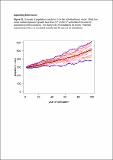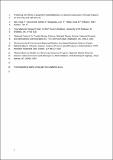Files in this item
Predicting the effects of polychlorinated biphenyls on cetacean populations through impacts on immunity and calf survival
Item metadata
| dc.contributor.author | Hall, Ailsa J. | |
| dc.contributor.author | McConnell, Bernie J. | |
| dc.contributor.author | Schwacke, Lori H. | |
| dc.contributor.author | Ylitalo, Gina M. | |
| dc.contributor.author | Williams, Rob | |
| dc.contributor.author | Rowles, Teri K. | |
| dc.date.accessioned | 2018-11-05T00:50:28Z | |
| dc.date.available | 2018-11-05T00:50:28Z | |
| dc.date.issued | 2018-02 | |
| dc.identifier | 251475991 | |
| dc.identifier | 6f73134a-fbfe-4a46-99ce-f68f101f4eb8 | |
| dc.identifier | 85034072894 | |
| dc.identifier | 000424177000044 | |
| dc.identifier.citation | Hall , A J , McConnell , B J , Schwacke , L H , Ylitalo , G M , Williams , R & Rowles , T K 2018 , ' Predicting the effects of polychlorinated biphenyls on cetacean populations through impacts on immunity and calf survival ' , Environmental Pollution , vol. 233 , pp. 407-418 . https://doi.org/10.1016/j.envpol.2017.10.074 | en |
| dc.identifier.issn | 0269-7491 | |
| dc.identifier.other | ORCID: /0000-0002-7562-1771/work/47136277 | |
| dc.identifier.other | ORCID: /0000-0001-7575-5270/work/56052197 | |
| dc.identifier.uri | https://hdl.handle.net/10023/16392 | |
| dc.description | This work was supported by funding from the International Whaling Commission's Pollution 2000+Program, the U.S. NOAA/NFMS Health and Stranding Response Program and the UK's Natural Environment Research Council (Grant Code SMRU 10001). | en |
| dc.description.abstract | The potential impact of exposure to polychlorinated biphenyls (PCBs) on the health and survival of cetaceans continues to be an issue for conservation and management, yet few quantitative approaches for estimating population level effects have been developed. An individual based model (IBM) for assessing effects on both calf survival and immunity was developed and tested. Three case study species (bottlenose dolphin, humpback whale and killer whale) in four populations were taken as examples and the impact of varying levels of PCB uptake on achievable population growth was assessed. The unique aspect of the model is its ability to evaluate likely effects of immunosuppression in addition to calf survival, enabling consequences of PCB exposure on immune function on all age-classes to be explored. By incorporating quantitative tissue concentration-response functions from laboratory animal model species into an IBM framework, population trajectories were generated. Model outputs included estimated concentrations of PCBs in the blubber of females by age, which were then compared to published empirical data. Achievable population growth rates were more affected by the inclusion of effects of PCBs on immunity than on calf survival, but the magnitude depended on the virulence of any subsequent encounter with a pathogen and the proportion of the population exposed. Since the starting population parameters were from historic studies, which may already be impacted by PCBs, the results should be interpreted on a relative rather than an absolute basis. The framework will assist in providing quantitative risk assessments for populations of concern. | |
| dc.format.extent | 577718 | |
| dc.format.extent | 188376 | |
| dc.language.iso | eng | |
| dc.relation.ispartof | Environmental Pollution | en |
| dc.subject | Individual based model | en |
| dc.subject | Risk assessment | en |
| dc.subject | Marine mammal | en |
| dc.subject | Contaminants | en |
| dc.subject | GE Environmental Sciences | en |
| dc.subject | QH301 Biology | en |
| dc.subject | DAS | en |
| dc.subject | BDC | en |
| dc.subject | SDG 14 - Life Below Water | en |
| dc.subject.lcc | GE | en |
| dc.subject.lcc | QH301 | en |
| dc.title | Predicting the effects of polychlorinated biphenyls on cetacean populations through impacts on immunity and calf survival | en |
| dc.type | Journal article | en |
| dc.contributor.sponsor | NERC | en |
| dc.contributor.sponsor | NERC | en |
| dc.contributor.institution | University of St Andrews. School of Biology | en |
| dc.contributor.institution | University of St Andrews. Sea Mammal Research Unit | en |
| dc.contributor.institution | University of St Andrews. Marine Alliance for Science & Technology Scotland | en |
| dc.contributor.institution | University of St Andrews. Scottish Oceans Institute | en |
| dc.identifier.doi | 10.1016/j.envpol.2017.10.074 | |
| dc.description.status | Peer reviewed | en |
| dc.date.embargoedUntil | 2018-11-05 | |
| dc.identifier.grantnumber | NE/R015007/1 | en |
| dc.identifier.grantnumber | Agreement R8-H12-86 | en |
This item appears in the following Collection(s)
Items in the St Andrews Research Repository are protected by copyright, with all rights reserved, unless otherwise indicated.


